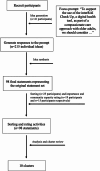Use of an electronic wellness instrument in the integrated health and social care of older adults: a group concept mapping study
- PMID: 39080598
- PMCID: PMC11288113
- DOI: 10.1186/s12913-024-11320-5
Use of an electronic wellness instrument in the integrated health and social care of older adults: a group concept mapping study
Abstract
Background: Health system fragmentation directly contributes to poor health and social outcomes for older adults with multiple chronic conditions and their care partners. Older adults often require support from primary care, multiple specialists, home care, community support services, and other health-care sectors and communication between these providers is unstructured and not standardized. Integrated and interprofessional team-based models of care are a recommended strategy to improve health service delivery to older adults with complex needs. Standardized assessment instruments deployed on digital platforms are considered a necessary component of integrated care. The aim of this study was to develop strategies to leverage an electronic wellness instrument, interRAI Check Up Self Report, to support integrated health and social care for older adults and their care partners in a community in Southern Ontario, Canada.
Methods: Group concept mapping, a participatory mixed-methods approach, was conducted. Participants included older adults, care partners, and representatives from: home care, community support services, specialized geriatric services, primary care, and health informatics. In a series of virtual meetings, participants generated ideas to implement the interRAI Check Up and rated the relative importance of these ideas. Hierarchical cluster analysis was used to map the ideas into clusters of similar statements. Participants reviewed the map to co-create an action plan.
Results: Forty-one participants contributed to a cluster map of ten action areas (e.g., engagement of older adults and care partners, instrument's ease of use, accessibility of the assessment process, person-centred process, training and education for providers, provider coordination, health information integration, health system decision support and quality improvement, and privacy and confidentiality). The health system decision support cluster was rated as the lowest relative importance and the health information integration was cluster rated as the highest relative importance.
Conclusions: Many person-, provider-, and system-level factors need to be considered when implementing and using an electronic wellness instrument across health- and social-care providers. These factors are highly relevant to the integration of other standardized instruments into interprofessional team care to ensure a compassionate care approach as technology is introduced.
Keywords: Aged; Care partners; Confidentiality; Medical informatics; Multiple chronic conditions; Privacy; Self-report; interRAI.
© 2024. The Author(s).
Conflict of interest statement
The authors declare no competing interests.
Figures



Similar articles
-
Factors related to screening for problem gambling among healthcare and social service providers in Ontario, Canada: A concept mapping study.Health Soc Care Community. 2020 May;28(3):791-802. doi: 10.1111/hsc.12909. Epub 2019 Dec 12. Health Soc Care Community. 2020. PMID: 31833129
-
Healthcare providers' experiences in supporting community-living older adults to manage multiple chronic conditions: a qualitative study.BMC Geriatr. 2019 Nov 19;19(1):316. doi: 10.1186/s12877-019-1345-2. BMC Geriatr. 2019. PMID: 31744477 Free PMC article.
-
Mapping the way: functional modelling for community-based integrated care for older people.Health Res Policy Syst. 2024 Aug 12;22(1):103. doi: 10.1186/s12961-024-01196-6. Health Res Policy Syst. 2024. PMID: 39135056 Free PMC article.
-
Identifying models of care to improve outcomes for older people with urgent care needs: a mixed methods approach to develop a system dynamics model.Health Soc Care Deliv Res. 2023 Sep;11(14):1-183. doi: 10.3310/NLCT5104. Health Soc Care Deliv Res. 2023. PMID: 37830206 Review.
-
Impact of summer programmes on the outcomes of disadvantaged or 'at risk' young people: A systematic review.Campbell Syst Rev. 2024 Jun 13;20(2):e1406. doi: 10.1002/cl2.1406. eCollection 2024 Jun. Campbell Syst Rev. 2024. PMID: 38873396 Free PMC article. Review.
Cited by
-
Advancements and Innovation Trends of Information Technology Empowering Elderly Care Community Services Based on CiteSpace and VOSViewer.Healthcare (Basel). 2025 Jul 7;13(13):1628. doi: 10.3390/healthcare13131628. Healthcare (Basel). 2025. PMID: 40648652 Free PMC article.
-
The Integrated Care Team: A primary care based-approach to support older adults with complex health needs.Healthc Manage Forum. 2025 May;38(3):192-199. doi: 10.1177/08404704241293051. Epub 2024 Oct 22. Healthc Manage Forum. 2025. PMID: 39434587 Free PMC article.
References
-
- Rabeneck L, McCabe C, Dobrow M, Ruco A, Andrew M, Wong S, et al. Strengthening health care in Canada post COVID-19 pandemic. Royal Society of Canada; 2023. https://rsc-src.ca/en/covid-19-policy-briefing/strengthening-health-care...
-
- Hudon C, Chouinard MC, Beaulieu MD, Bisson M, Bouliane D, Couture M, et al. Towards better health, social, and community-based services integration for patients with chronic conditions and complex care needs: stakeholders’ recommendations. Int J Environ Res Public Health. 2020;17(8437):1–7. 10.3390/ijerph1722843710.3390/ijerph17228437 - DOI - PMC - PubMed
-
- National Academies of Sciences Engineering and Medicine. Integrating social care into the delivery of health care: moving Upstream to improve the nation’s health. Washington (DC): National Academies; 2019. - PubMed
MeSH terms
LinkOut - more resources
Full Text Sources

